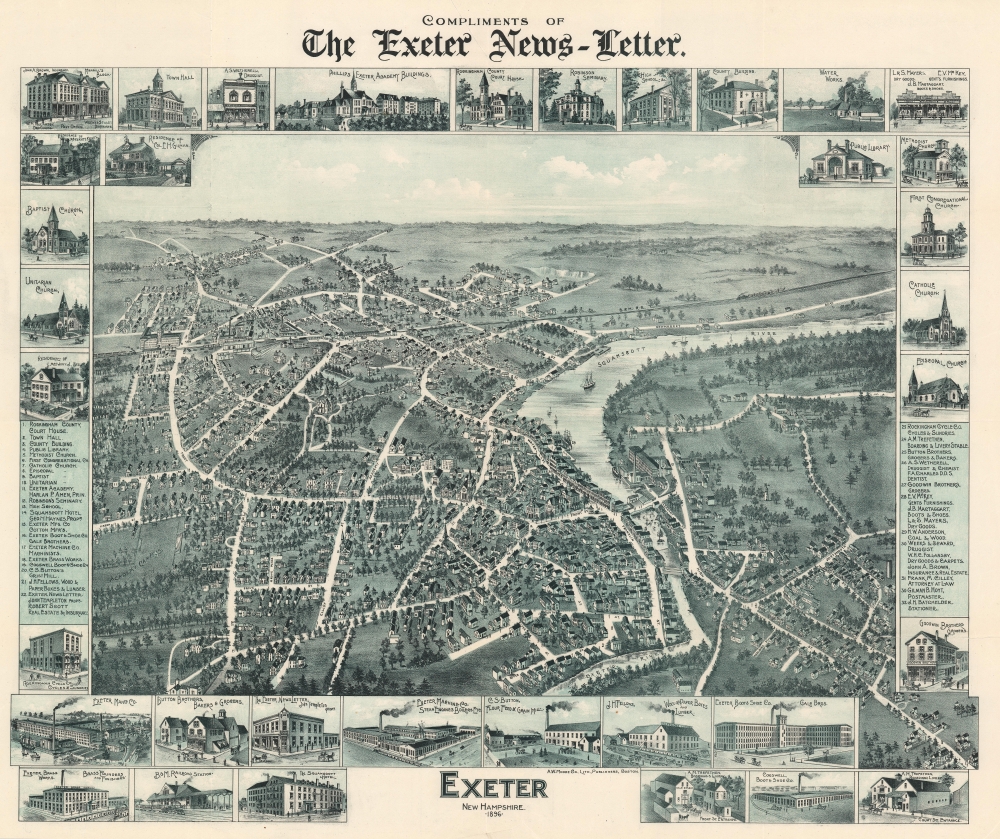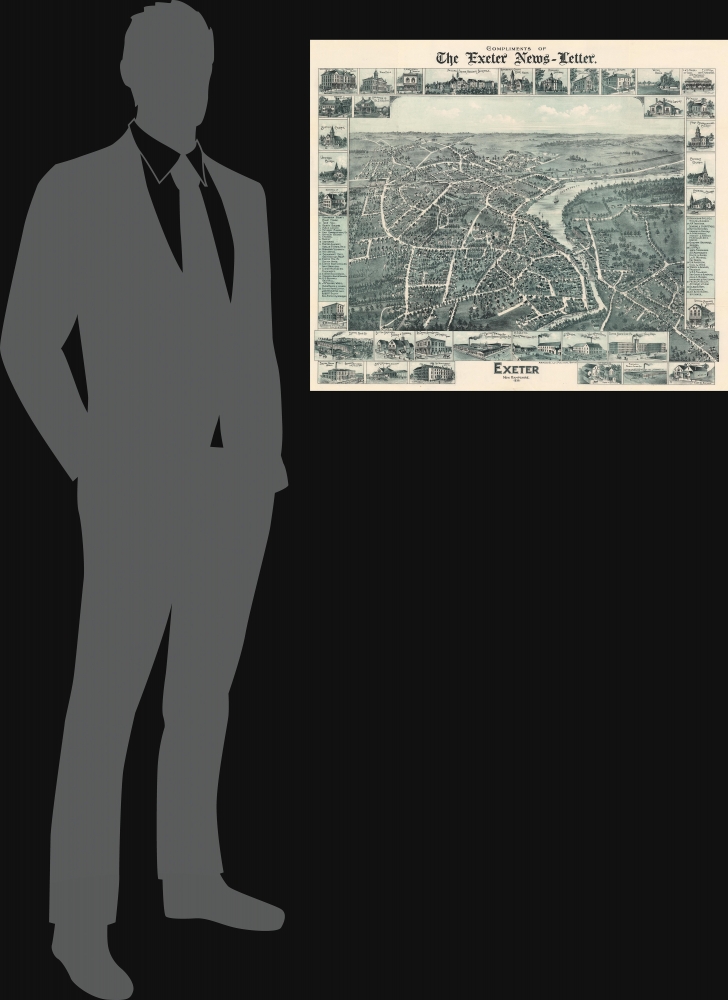1896 Moore Bird's Eye View Map of Exeter, New Hampshire
Exeter-moore-1896$2,000.00

Title
Exeter New Hampshire.
1896 (dated) 27 x 33 in (68.58 x 83.82 cm)
1896 (dated) 27 x 33 in (68.58 x 83.82 cm)
Description
This is an 1896 A.W. Moore two-color chromolithograph bird's-eye view map of Exeter, New Hampshire. The view illustrates Exeter as a small but thriving town well connected to via the Boston and Maine Railroad. The view also illustrates Phillips Exeter Academy, a prestigious and still-active boarding school founded in 1781.
Numerous streets are labeled, including Windmill Street in the upper left, which never officially existed. The only record of a Windmill Street existing in Exeter is in this view, and it was only referred to as Windmill Street informally, due to the presence of a recently built windmill nearby (also illustrated). It soon became Locust Street and lost its informal moniker.
City views were being produced in the United States as early as the 1830s, but the genre exploded after the American Civil War (1861 - 1865). Bridging the gap between maps and pictures, most 19th century American bird's-eye views presented cities to the public from highpoints. Some were imagined, but others were drawn from hot-air balloons or nearby hills. The presentation, combining high elevation, commercial interest, and new printing technology created a uniquely American artform, as described by historian Donald Karshan,
A Closer Look
The view depicts the city from the Phillips Exeter Academy campus on the left to Squamscott River and from Epping Road and Brentwood Street in the background to the Exeter River. Buildings are illustrated in profile throughout the view, with thirty-two locations numerically identified and corresponding with an index split between the right and left borders. Some of these buildings include Phillips Exeter Academy, churches and local businesses, and the county courthouse. The whole is surrounded by thirty-five vignettes of locations around town, providing detailed views of the Philips Exeter Academy (situated just to the left of center along the top border), many of the town's churches, the Town Hall, the Rockingham County Court House, the high school, and the public library.Numerous streets are labeled, including Windmill Street in the upper left, which never officially existed. The only record of a Windmill Street existing in Exeter is in this view, and it was only referred to as Windmill Street informally, due to the presence of a recently built windmill nearby (also illustrated). It soon became Locust Street and lost its informal moniker.
American Bird's-Eye City Views
The tradition of the bird's-eye city view emerged in the United States in the middle part of the 19th century and coincided with the commercial development of lithographic printing. While before the rise of lithography, the ability to own and display artwork in the home was largely limited to the extremely wealthy, lithographic printing made it possible for everyone to own visually striking artwork. A robust trade developed in portraits of political leaders, allegorical and religious images, and city views.American Bird's-Eye City Views
The Bird's-Eye view industry emerged in the United States in the middle part of the 19th century and coincided with the commercial development of lithographic printing. Before the rise of lithography, the ability to own and display artwork in the home was largely limited to the extremely wealthy, but the advent of lithographic printing made it possible for everyone to own visually striking artwork. A robust trade developed in portraits of political leaders, allegorical and religious images, and city views.City views were being produced in the United States as early as the 1830s, but the genre exploded after the American Civil War (1861 - 1865). Bridging the gap between maps and pictures, most 19th century American bird's-eye views presented cities to the public from highpoints. Some were imagined, but others were drawn from hot-air balloons or nearby hills. The presentation, combining high elevation, commercial interest, and new printing technology created a uniquely American artform, as described by historian Donald Karshan,
Some print connoisseurs believe that it was only with the advent of the full-blown city-view lithograph that American printmaking reached its first plateau of originality, making a historical contribution to the graphic arts. They cite the differences between the European city-view prints and the expansive American version that reflects a new land and a new attitude toward the land.The vogue for bird's-eye city views lasted from about 1845 to 1920, during which period some 2,400 cities were thus portrayed, some multiple times. Although views were produced in many urban centers, the nexus of view production in the United States was Milwaukee, Wisconsin. The major American viewmakers were Stoner, Wellge, Bailey, Fowler, Hill Ruger, Koch, Burleigh, Norris, and Morse, among others.
Chromolithography
Chromolithography, sometimes called oleography, is a color lithographic technique developed in the mid-19th century. The process involved using multiple lithographic stones, one for each color, to yield a rich composite effect. Oftentimes, the process would start with a black basecoat upon which subsequent colors were layered. Some chromolithographs used 30 or more separate lithographic stones to achieve the desired product. Chromolithograph color could also be effectively blended for even more dramatic results. The process became extremely popular in the late 19th and early 20th centuries, when it emerged as the dominate method of color printing. The vivid color chromolithography produced made it exceptionally effective for advertising and propaganda imagery.Publication History and Census
This bird's eye view was published by A.W. Moore Lithography Publishers in Boston in 1896. Only two examples are catalogued in the OCLC: Library of Congress and Pennsylvania State University.Condition
Very good. Wear along original fold lines. Verso reinforcements along original fold lines and at fold intersections. Closed tear extending 2.25 inches into printed area from top margin professionally repaired on verso.
References
OCLC 5451218.




